Kefalonia Greek Island. History, Holidays, Hotels And Things To Do.
Kefalonia, Cephalonia,Kefallonia, Cephallonia and Kefallinia are all names that this stunning island off the west coast of Greece is known by. Whatever name you prefer, they all refer to a welcoming, beautiful and stunning holiday destination. An island worth visiting if you want to experience the Greek Islands.
It is ideal for travellers with a week off work who want to experience a taste of a perfect Greek Island. It has a lot of variety and, importantly, many beautiful beaches to explore and enjoy.
In this post I will look at what you need to know and give you my top tips for making sure that you get the most of your trip to Kefalonia.
Where is it?
Kefalonia is part of the Ionian Island group. These islands off the west coast of Greece are also known as the “Seven Islands”, although there are many smaller ones in the group too. The map above shows the location and what the other islands are in the group. The capital is Argostoli and 4km across the bay is the second largest town called Lixouri. Over two-thirds of the population lives in these 2 towns.
- Second World War and “Captain Corelli’s Mandolin”. In the Second World War it was occupied mostly by Italian Forces backed up by some German troops. Just after Italy reached an armistice with the Allied Forces in 1943, German troops massacred around 5000 of the 9000 Italian Troops based there. The Louis de Bernieres book and the 2001 film “Captain Corelli’s Mandolin” is set before and after the massacre. It was filmed in Kefalonia, mostly in and around Sami and Antisamos beach. The film was subject to much debate and concern over the politics of the story, and was toned down to reflect this. There is also a 2005 Italian film called “Cefalonia” which focuses more on the events, but also tells a love story. In the 1950s some 3000 bodies were exhumed and returned to Italy to be buried in a military graveyard.
- 1953 Earthquake. In 1953 an earthquake destroyed most of the property across the island, with only the very north around Fiscardo being spared. Around 100000 of the 125000 population left the island for good, and still today the population of the island has only grown back to 45000. The island is on an earthquake fault and has suffered from various tremors over the years. The strongest being in 2003 (5.3 on Richter Scale) and 2005 (4.9 on Richter Scale).
- Much more scenic, mountainous and the beaches were more beautiful than I had ever imagined. The island has huge mountains covered thickly with pine trees. It has many gorgeous bays and beaches nestling at the base of these large mountains. Often it is a steep and winding drive down to the main beaches. It is very beautiful.
- Friendly and welcoming. Despite, or perhaps because of, the huge tourist traffic the people are incredibly open and warm. They make you feel very welcome and seem very pleased that you have chosen to come to visit their island.
- Not a rip off. I had expected, like so many tourist destinations, that prices would be unreasonable. However prices were very fair, and cheaper in many cases than I am used to in London. This was especially true with food and drink.
- Very UK tourist base. Despite its location and proximity to Europe, it seems that the bulk of tourists are from the UK. Although many websites report that it is a popular destination for Italians, and Italians did seem to be the second most prevalent group of visitors. The Brits by far were the bulk of visitors we came across.
- English. Possibly due in part to the above, English feels like the first language on the island! Everyone speaks excellent English and the starting point of conversations and greetings seemed to be in English. No excuse for not learning a few Greek welcoming and thank you phrases though.
- Safe. The island feels, and has a reputation for being, very safe and secure. People are very relaxed about security and we noticed that many even leave their car windows open when parked.
- Restaurants all very similar menus. Again probably driven by the tourist demands, most restaurants are very similar in style and have a standard menu featuring moussaka, souvlaki, and similar Greek dishes. They all have very low priced house local wine.
- Some things to remember:
- Toilets. The plumbing on Kefalonia, like much of Greece, does not cope with toilet paper and so they have bins to use for paper instead of flushing it. It takes a bit of getting used to, but soon becomes habit.
- Opening Hours. Shops and banks tend to open early and close around lunchtime and then open at the end of the afternoon again as the temperature cools down. Some of the larger supermarkets like Carrefour now tend to stay open instead of closing.
- Cash versus Cards. Also likely due to the tough economic times Greece is going through, retailers and other service providers prefer you to pay in cash versus cards. Some places do not take cards, so try and take Euros and pay as often as you can in cash. It is appreciated.
The season is from May to October, although the main season is concentrated in July and August. Most of the hotels, restaurants and many shops close from the end of October until Easter the next year. September is an especially good time to go as the crazy busy season has passed and the weather is warm without being too oppressive (around 30 degrees).
- Flying: The most common way to get there is, of course, flying. It is around a 3 hour flight from the UK, less from other parts of Europe. The airport opened first in 1971 and the tourism trade build fast from there. The current airport and terminal opened in the 1980s. It is packed and busy in the season, and the terminal is really a bit too small for the volume of people passing through it. Most of the flights are from the UK and a combination of charter (Thompson and Thomas Cook) and low price airlines like EasyJet and RyanAir. There are very regular flights and lots of options in the main season from May to September.
- Cruise. Kefalonia has a cruise ship dock in Argostoli and is appearing on various major cruise line routes. While we were there, for example, Cunard’s Queen Victoria paid a visit. One option is to see Kefalonia as part of a cruise.
- Yachting. Another option is to join a small yacht cruise on a yacht like Harmony V. This, and others like them, are super yachts that have up to 45 cabins and travel from Athens on 7 night routes around various islands, docking in bays and some of the picturesque towns. This may be a good way to spend a week getting a taste of different islands to help decide which ones you want to revisit for longer.
- Package Tours. It seemed to me that most of the people on our flight where on a package tour which included the flight, transfers and accommodation. Looking at travel sites selling them like HolidayHypermarket.co.uk most of the packages seem to be self catering, which I recommend so you get out to experience the island and different restaurants and experiences. More of that later in the post.
- The best way to get around is by car. There are many hire companies at the airport including companies like Hertz and Avis. It is best to book before you arrive, especially in the peak season. To see the best of Kefalonia you should travel around the island rather than stay in the area you are based. The roads are generally narrow, although on main routes they are wider with a clear lane each way. Many of the roads weave over high mountains, and so you need to be a confident driver and have a good head for heights. Parking is free in most places, although there is some charging now on the port front in Argostoli. You drive on the right hand side, so UK travellers need to adjust. Unlike many countries traffic roundabouts work differently and cars on the roundabout must give way to cars entering the roundabout.
- Taxis. There are also a lots of taxis in all the towns, and so this is an option. We saw many people using taxis to travel to the beaches for example.
- Google Maps and Smart Phone. It can be fairly challenging to find your way around at times, with varied degrees of signposting. Our stat nav did not work on the island. One thing we found was even better than using maps was to use the Google Map App on our Smartphone, which has excellent map and routing to find your way around Kefalonia. With the new lower mobile phone and data charges required by the EU from mobile phone providers, it can be cost effective too. For example, O2 (my mobile provider in the UK) charges a maximum of £1.99 ($3) a day for as much data as you need.
- Hiring a villa versus staying in hotels or resorts is a popular option and recommened. Many can be hired with swimming pools. We stayed in a 3 bedroom villa called Korianna House in the Southern part of the island which is stylish, with views across to the ocean and handy to explore the island. To see my review, video and photos of Korianna House: click here
- Most tourists tend to stay in the Lassi area, which is near to Argostoli and has resorts, hotels and apartments with lots of shops and restaurants. It tends to be younger and quite busy and buzzing. The next most popular tourist areas are in the south near to Skala or Katelios. To see a range of hotels click here. Many tourists seemed to prefer to book packages via providers like Thomson and Thomas Cook, but worth looking at independent travel as an alternative and book a villa through sites like Holiday Rentals, Holiday Lettings.
- In the North is the popular Fiscardo, where the rich and famous come with their yachts and dock there or off shore. It is known for attracting famous names and while we were there, for example, Ronan Abramovich’s mega yacht was docked off Fiscardo.
I would recommend that you use your time to focus on visiting the most important beaches on the island. This will also mean that you get to tour and see the stunning mountain areas and some of the charming towns. As well as the main beaches, you will find isolated spots all around the island to stop and swim on.
- What you need: I recommend that you buy some of the rubber shoes that are sold in most of the tourist shops for under 10 Euros. Some of the beaches are pebbles and these shoes are ideal. Most of the major beaches have umbrellas and loungers which cost around 7 Euros a day per couple. But they all also have large areas to sit and lie on the beach where you can bring your own umbrellas too. So be prepared to pay or bring your own shade!
- Beaches to visit:
- Antisamos & Sami. This is my most highly recommended beach. On the East Coast just outside Sami, you get there down a long winding road. It is a pebble beach that gets deep very fast with very clear water and loads of fish. It is great for snorkelling too. There are 2 beach bar/ restaurants with good food and friendly service. Sami is where Captain Corelli was filmed with sets built nearby, and the beach was used to film the Italian encampments. Sami is a very pretty port where day trip boats and a Ferry runs to the nearby island of Ithaki.
- Fiscardo. This has a lovely port area with yachts docked and lots of coffee shops and restaurants. There are some smaller beaches nearby. It is well worth visiting to do people and yacht watching. The beaches are not as good as some of the others on the island but it is worth taking time to visit this pretty and interesting village.
- Myrtos. One of the most famous and popular beaches. It is reported to be the most photographed beach on the island. It has a very broad and wide sandy beach. Often there will be large yachts anchored off the beach. It has a beach bar with some limited food options.
- Petani. This is a large bay with a pebble beach. To get there you can either drive all round the bay (which will take at least 40 minutes) or take the ferry from Argostoli to Lixouri. It takes 30 minutes from time of driving on to getting off. This is highly recommended as you get great views of the island. In summer it goes every 30 minutes, and every hour other times. It is very reasonable and costs 2,5 euros per person plus 3,5 euros for the car. It is then about 20 minutes drive to the beach. There are 3 places to eat on the beach with good food. The sea tends to be more rough and has waves unlike beaches like Antisamos and Myrtos.
- Avithos. This popular and sandy beach is not far from the airport in the south east of the island. It is a more narrow beach and very popular. There are 2 very good taverns at the beach. One at the top of the hill and one at beach level. On the beach is a bar.
Assuming you are there for a week, seeing all the amazing beaches will take up most of your trip. However, there are a number of other well worth things to do and see if you want a distraction from the beaches. These are my 5 top tips:
- Argostoli. Although it has been rebuilt after the earthquake and is not as quaint as it could be, it still is worth spending time in. The best time to visit is on a Friday evening. The area around the main town square (a few blocks back from the port side road) is closed to traffic and locals and tourists gather to meet, chat, people watch, drink and eat. It is very busy and buzzing. All round the square are trendy bars to sit and enjoy the mood. A block from the square is a pedestrianised shopping road. The best restaurant on the island that we visited is just off the square down a side alley and called Casa Grec. Great food, great outside area to sit and very friendly staff. In the day time the area along the port is worth visiting, especially if a cruise ship is in town, and there is also a large fruit and vegetable market.
- Drogarati Caves and Melissani Lake. These incredible natural phenomena are on the east coast close to Sami. The inland lake within open caves is a mixture of sea and fresh water and you can take a boat ride around the unusual shape and see the stunning colour of the water. The caves became more accessible after the earthquake as it opened an entrance. Inside are many stalactites and stalagmites created from the rain.
- St Georges’s Castle. The castle sits high on the top of a hill and used to be a view point to defend the settlements of the island. Now in ruins it is open some days to explore, but even if closed the views across the island are impressive. Around the castle are many great restaurants.
- Boat trips from Agostoli, Ficardo and Sami. There are many day trips leaving from each of these ports where you can either tour up one of the coasts, stopping for swimming stops in beautiful bays. One of the more popular trips is an all day trip from Sami to the island of Ithaki off the east coast. One of the operators is Captain Vangeli Boats
- Wineyards. There is a thriving Kefalonia wine business and you can visit the main ones and have tastings. The main ones to consider are the Robola Coperative near the Monastry of St Gerasimos, Metaxas Wine Estate and Divino. The Robola is situated in beautiful valley and would be the one I would recommend.
Kefalonia is a beautiful island that has huge fir tree covered mountains and stunning clear sea beaches. It was the first Greek Island that I have been to, and was a perfect introduction to Greece and the look and feel of the Greek Islands. If you have a week to spare I would highly recommend going there.
Links
- Photos
- Korianna House Review and Video
- http://en.wikipedia.org/wiki/Cephalonia
- http://en.wikipedia.org/wiki/Massacre_of_the_Acqui_Division
If you liked this post, please share it on your favourite social media site using the sharing buttons. I would really appreciate it if you Sign up for the eMail Newsletter (Don’t miss any future posts!), join my Facebook Page, Twitter and/or Subscribe to the Podcast. Thanks

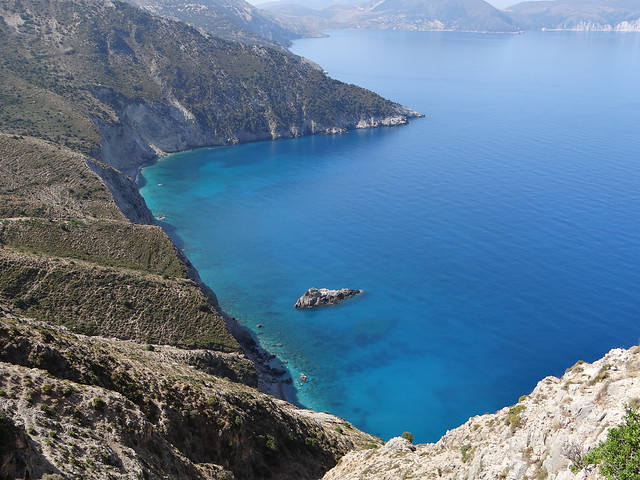
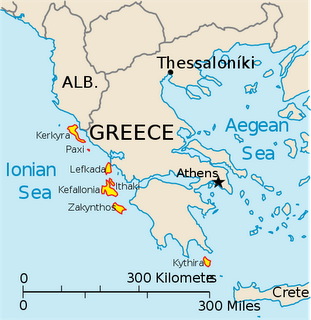
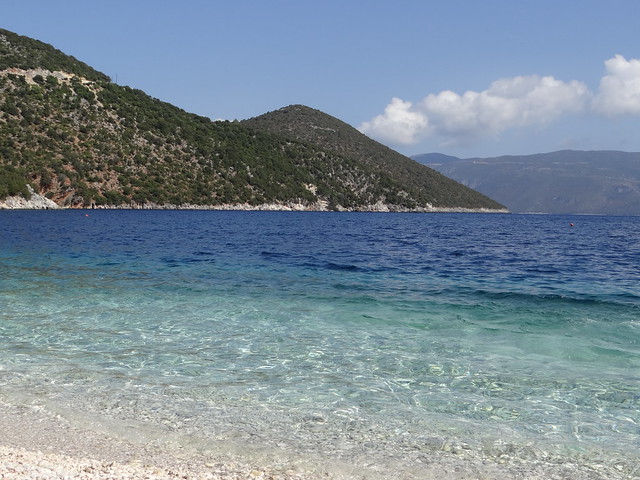
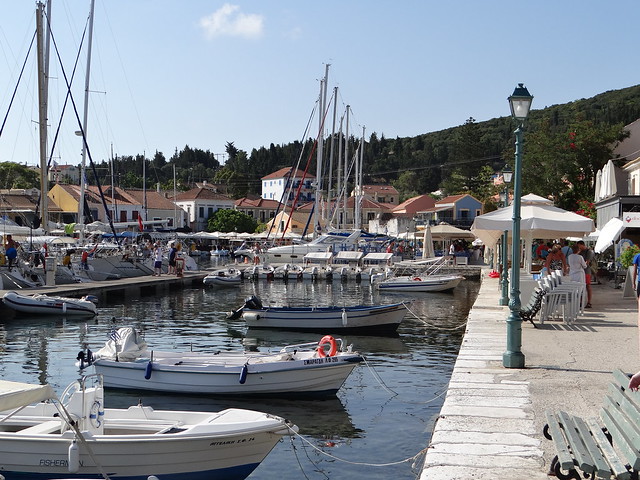
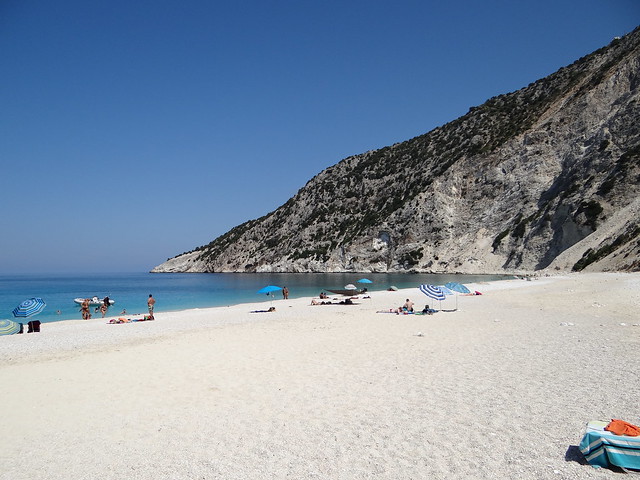
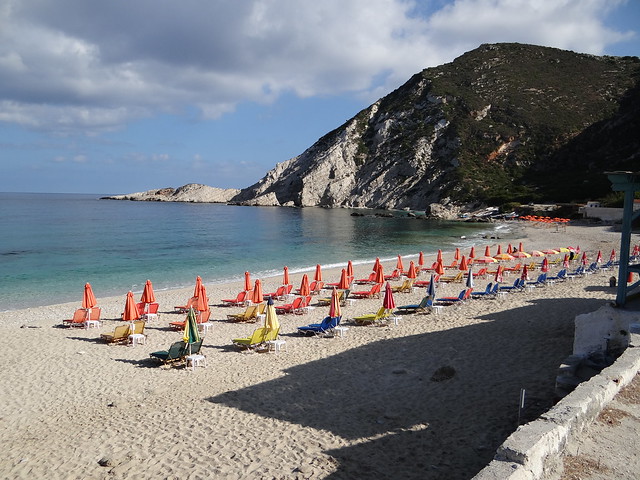
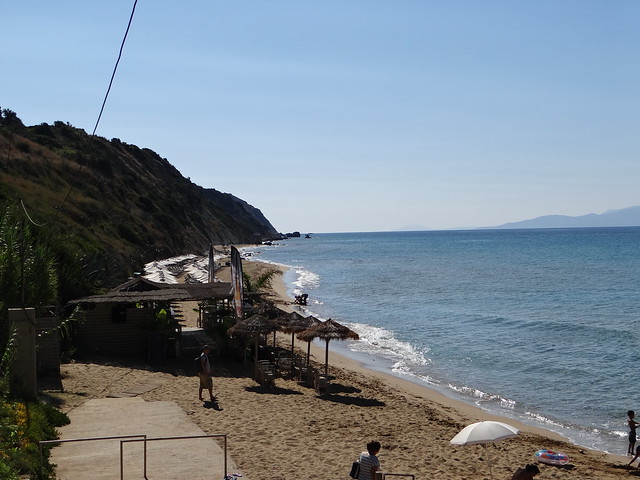
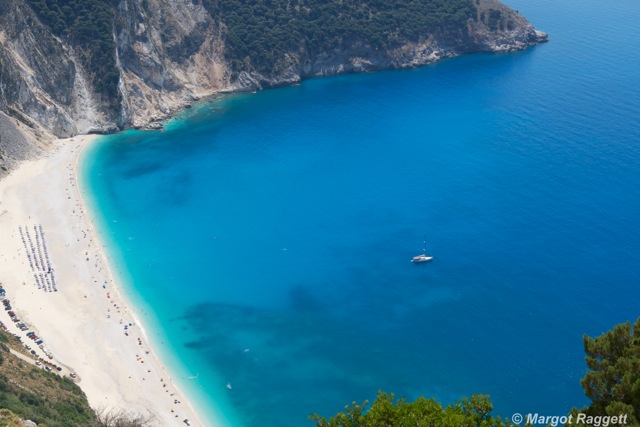
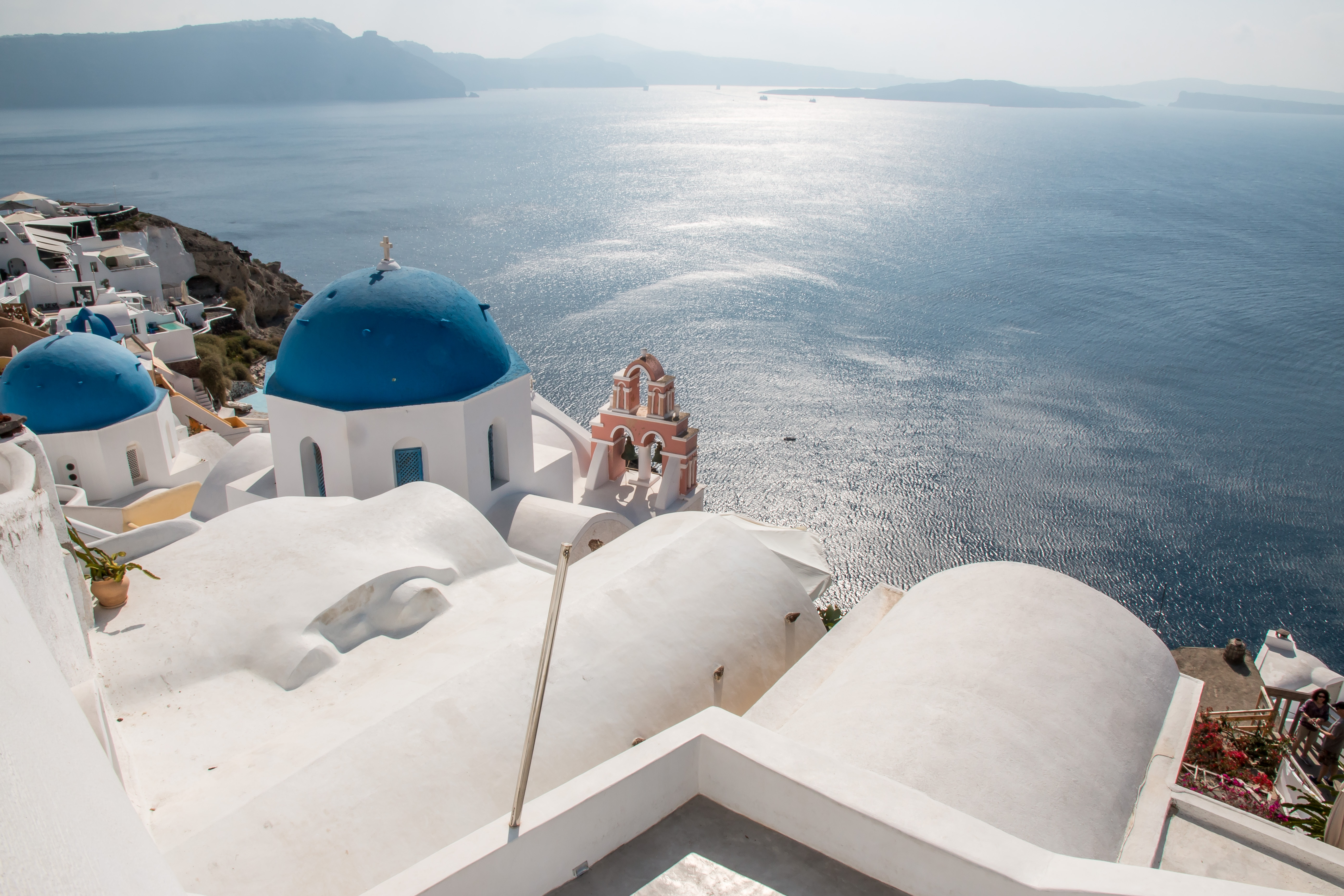
Have long dreamed about the Greek Islands.
I think I'm sold. Kefalonia sounds lovely – I like the sound of a trip to explore the caves and lake. And maybe some wine tasting! Thanks for some really useful tips and info.